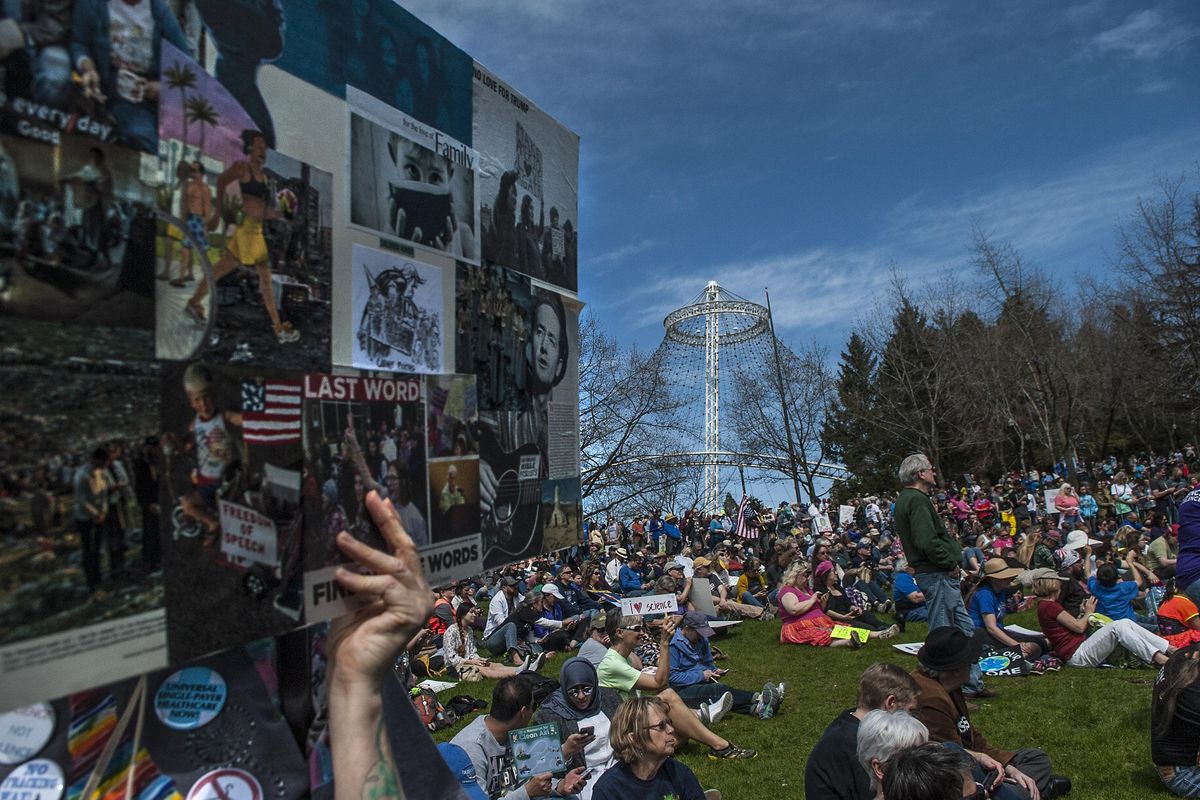Scientists and supporters rally at Spokane’s Riverfront Park
Mary Naber of the Raging Grannies walks through the crowd during the March for Science in Spokane on Saturday, April 22, 2017. (Kathy Plonka / The Spokesman-Review)Buy a print of this photo
The speeches had only just begun, but the field in front of the clock tower was crowded with thousands of people when the Spokane March for Science got underway Saturday afternoon.
The Raging Grannies, a Spokane offshoot of the international network of grandmotherly activists, sang protest songs about the protection of air and water. Families clustered around trestle tables piled with markers and poster board, sketching signs to wave in the upcoming rally.
Many people don’t realize that the federal government pays for much of the research into everything from Alzheimer’s to AIDS, said Gonzaga University biology instructor Amanda Brailey. “When we look at an administration that wants to reduce funding for science, that worries us,” she said.
Brailey said she and other scientists who helped organize the rally hope the people attending will become involved at a grass roots level.
Spokane’s March for Science was one of 600 that took to the streets Saturday across the United States, in Europe and Asia. Supporters said they felt compelled to act against the Trump administration’s proposed cuts to science research and development, and to push back against the attitude of skepticism and ambivalence the administration has shown towards areas of science with which its interests do not align.
Still, organizers and some marchers were careful to specify that their rally was not against the Trump administration itself, or against the president, but rather in response to his policies and proposed budget cuts. “Science is not a partisan issue,” said Nancy Staub, a professor of biology at Gonzaga University and one of the march’s keynote speakers. “It applies to everyone, it affects everyone.”
When Staub spoke to the crowd from the tiny stage, she held a hammer high over her head. Science, like a hammer, is a tool that can be used to do many things. But nobody walks around saying they don’t believe in the hammer, she said.
“Science is not a belief system. It is not a set of opinions,” she said.
She said she’s worried about the proposed 31 percent cut in funding for the EPA because it would not be enacted across the board. “He’s taking a scalpel and targeting scientific programs themselves,” she said.
Scientists have raised alarm bells over proposed cuts to agencies like the National Institute of Health and the Environmental Protection Agency, as well as comments Trump made on the campaign trail questioning the science behind vaccination and climate change. Bailey said that, whatever your political leanings, cutting back on science could hurt the field as a whole.
“All of the scientists I know, to some degree, were trained with the benefit of public funding,” she said.
The march set off once the speeches had concluded, moving west on Spokane Falls Boulevard and then turning north toward City Hall. At one point, the marchers who filled the street stretched nine city blocks.
Dr. Erin Medina, who practices family medicine, wore her lab coat and stethoscope and carried a sign that said “Vaccines save lives.” She said she hoped to send the message that people are concerned about science and they care.
“I think science is important,” she said. “I’m worried about funding for scientific research being cut, and I’m worried about climate change science and the EPA.”
For some of the protesters, however, the line between president and policy was far from clear. “I’m here because I believe in science, and I’m also here to protest Trump,” said Pamela Davis, who came to the park to march. Describing herself as deeply religious, she said that she believes science to be an important avenue in the pursuit of objective truth.
“The current administration is confused,” she said. “Who blocks science?”






